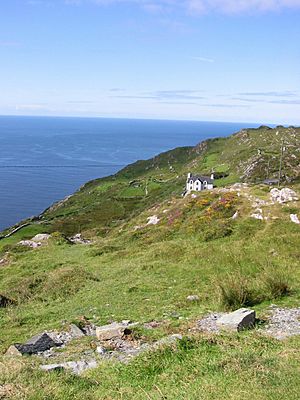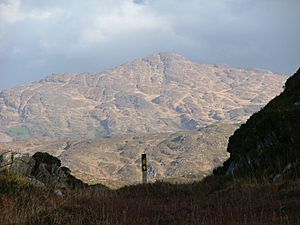Sheep's Head facts for kids
Sheep's Head is a beautiful piece of land that sticks out into the sea in County Cork, Ireland. It's also called Muntervary in Irish. This special place is located between two large bays, Bantry Bay and Dunmanus Bay.
It's a very popular spot for people who love to walk and explore. The area is famous for its amazing views and peaceful trails.
Contents
Walking and Cycling Trails
The Sheep's Head peninsula is home to the Sheep's Head Way, a long walking trail. This trail is about 88 kilometers (55 miles) long. It follows old paths and roads around the peninsula.
The Sheep's Head Way Walking Trail
The walking trail starts and ends near Bantry. It's easy to follow because it has good signs. The path takes you through low hills, along the coast, and past tall cliffs.
You can walk this trail between April and October. It's divided into eight shorter parts, each taking about half a day to walk. Some people who helped create this trail were Tom Whitty, James O’Mahony, and Jim Leonard.
There are also 20 smaller loop walks connected to the main Sheep's Head Way. These trails go further east to places like Kealkill, Drimoleague, and Gougane Barra. Here, the Sheep's Head Way connects with another big trail called the Beara-Breifne Way.
The Sheep's Head Way Cycle Trail
If you prefer cycling, there's a special bike trail too! It starts in Ballylickey, County Cork. The cycle trail goes all around the coast of the Sheep's Head peninsula. It finishes in a village called Ballydehob.
Villages of Sheep's Head
The peninsula has three charming villages.
- Durrus is about 6 miles (10 km) from Bantry. It's a key stop on the Wild Atlantic Way, a famous driving route along Ireland's coast. Durrus is also known for its local Durrus Cheese.
- Ahakista is about 12 miles (19 km) from Bantry.
- Kilcrohane is about 16 miles (26 km) from Bantry.
Awards and Recognition
The Sheep's Head peninsula has won several awards for being a great place to visit.
- In 2009, it was named a European Destination of Excellence for Sustainable Tourism. This means it's a great example of tourism that protects the environment and local culture.
- In 2015, Sheep's Head won a Silver award at the Irish Responsible Tourism Awards. It was also considered for the 'Best Destination' award in the World Responsible Tourism Awards.
- The local tourism group also received a special award at the Irish Tourism Industry Awards in 2015.
Ancient History and Archaeology
The Sheep's Head area has many old sites that tell us about its past. These include ancient burial grounds, forts, and standing stones. They show that people have lived here for thousands of years.
Archaeological Finds in Durrus
- Boulder Burials: Large stones covering ancient graves.
- Burial Grounds: Old places where people were buried.
- Cairns: Piles of stones used as memorials or burial markers.
- Castles: Remains of old strongholds.
- Fulacht Fiadh: Ancient cooking pits from the Celtic Iron Age (around 600 BC - 400 AD).
- Promontory Forts: Forts built on headlands, also from the Celtic Iron Age.
- Ring Forts: Circular forts, common in the Celtic Iron Age.
- Standing Stones (Gallauns): Tall, upright stones from the Bronze Age (around 2200 - 600 BC).
- Stone Circles and Rows: Groups of stones arranged in circles or lines, also from the Bronze Age.
Archaeological Finds in Kilcrohane
- Ringforts: Many circular forts from the Celtic Iron Age.
- Holy Wells: Special wells believed to have healing powers.
- Cashels: Stone forts.
- Bardic School: A place where poets and storytellers were trained in medieval times.
- Souterrains: Underground passages or chambers.
- Signal Towers: Old towers used to send signals along the coast.
Wildlife and Nature
The Sheep's Head peninsula is a special place for nature lovers.
- Owen's Island is a small island nearby.
- The coastal areas have unique plants like the Viola lactea (pale dog violet) and Tuberaria guttata (spotted rock-rose).
- You can also spot interesting birds here, such as choughs and fulmars.
- The peninsula is a protected area for birds like peregrine falcons and choughs. This means their homes are kept safe here.
Sheep's Head in Books
This beautiful area has even appeared in famous books!
- In David Mitchell's 2014 novel The Bone Clocks, Sheep's Head is a very important place. The last part of the book takes place here. One of the main characters, Mo Muntervary, even gets her last name from the old name for the headland.
- The writer JG Farrell, who had Irish family, moved to Sheep's Head after he stopped writing. Sadly, he died there in a storm when he was 44 years old.



